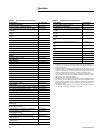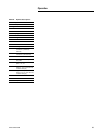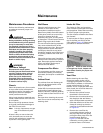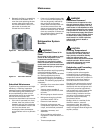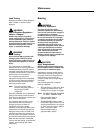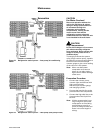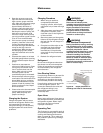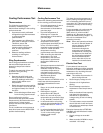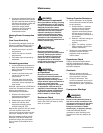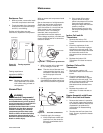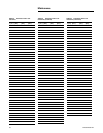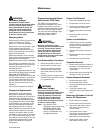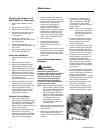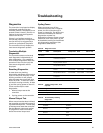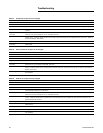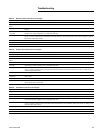
36 PTAC-SVX01C-EN
Maintenance
3. Locate the readings listed in the
Operation section of this manual.
You will note that these readings
fall within the voltage, watts and
amp draw minimum and
maximum ranges listed.
Therefore, the unit heating
performance would be
considered normal.
Heating Power Consumption
Te s t
(Heat Pump Mode Only)
For the heating wattage, record the
following readings after the unit is
interconnected with a wattmeter.
• Outside coil inlet air dry-bulb
temperature.
• Inside coil inlet air dry-bulb
temperature.
• Total watts input measured by
wattmeter.
Calculating procedure
1. Locate temperature obtained in
Step A of cooling performance
test in first column of Heating
Wattage Chart.
2. Locate in second column the
inside coil inlet dry-bulb
temperature.
3. The total watts input should
come between minimum and
maximum values indicated for
each model.
Example: Assume that a PTHE1501 is
under test. Proceed as follows and
observe test readings as
simultaneously as possible.
1. Outside coil inlet dry-bulb
temperature readings as
described above: 45°F.
2. Check watts input: 1370 W
3. Inside coil inlet dry-bulb
temperature reading as de
scribed in Step B: 75°F.
Read to the right from the 75° inside
coil inlet dry-bulb value in the
column and note the minimum and
maximum wattage of 1335 - 1470.
Since the wattage reading (1370)
obtained in the test is within the
prescribed range, the total power
input in watts is considered to be
normal.
WARNING
Live Electrical Components!
During installation, testing, servicing
and troubleshooting of this product,
it may be necessary to work with live
electrical components. Have a
qualified licensed electrician or other
individual who has been properly
trained in handling live electrical
components perform these tasks.
Failure to follow all electrical safety
precautions when exposed to live
electrical components could result in
death or serious injury.
WARNING
Hazardous Voltage!
Disconnect all electric power,
including remote disconnects before
servicing. Follow proper lockout/
tagout procedures to ensure the
power can not be inadvertently
energized. Failure to disconnect
power before servicing could result
in death or serious injury.
WARNING
Hazardous Voltage
w/Capacitors!
Disconnect all electric power,
including remote disconnects and
discharge all motor start/run
capacitors before servicing. Follow
proper lockout/tagout procedures to
ensure the power cannot be
inadvertently energized. Verify with
an appropriate voltmeter that all
capacitors have discharged. Failure
to disconnect power and discharge
capacitors before servicing could
result in death or serious injury.
Resistance Check
Discharge capacitor and remove wire
leads. Use a DC volt meter to verify
there is no power.
Testing Capacitor Resistance
1. Set an ohmmeter on its highest
ohm scale and connect the leads
to the capacitor.
a. Good Condition - indicator
swings to zero and slowly
returns to infinity. (Start
capacitor with bleed resistor
will not return to infinity. It
will still read the resistance of
the resistor).
b. Shorted - indicator swings to
zero and stops there -
replace.
c. Open - no reading - replace.
(Start capacitor would read
resistor resistance).
2. Testing for ohms between either
capacitor terminal and the
capacitor body must show
infinite ohms.
Capacitance Check
Using a hookup as shown below,
take the amperage and voltage
readings and use them in the formula
below the diagram.
Overloads
1. With no power to the unit,
remove the overload lead from
the compressor terminal.
2. Using an ohmmeter: Test
continuity between terminals of
the overload. If not continuous,
the overload is open, replace the
overload.
Compressor Windings
WARNING
Electrical Shock!
Do not connect electrical power to
this unit or to the compressor if the
compressor terminal cover has been
removed or is not firmly in place.
Doing so could result in death,
serious injury, or property damage.
If the test indicates shorted,
grounded or open windings, see
procedure for the next steps to be
taken.



